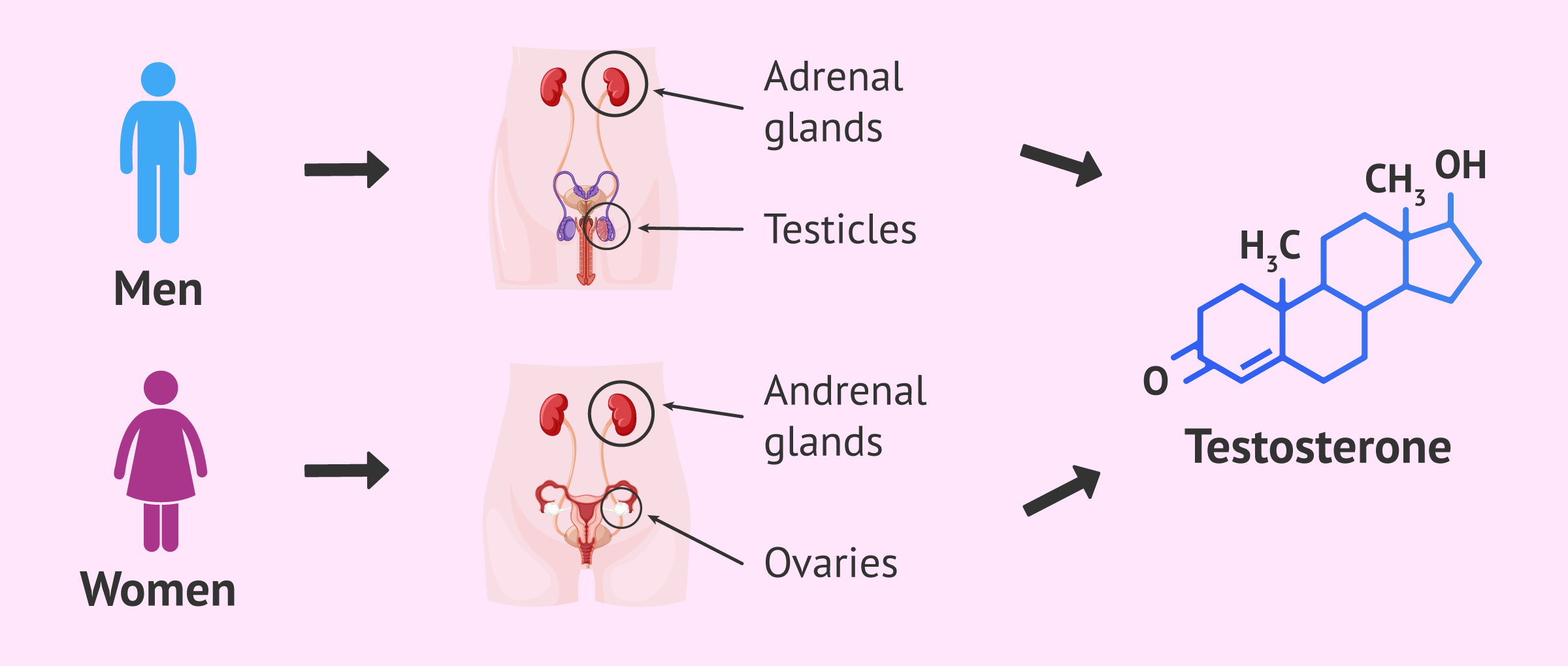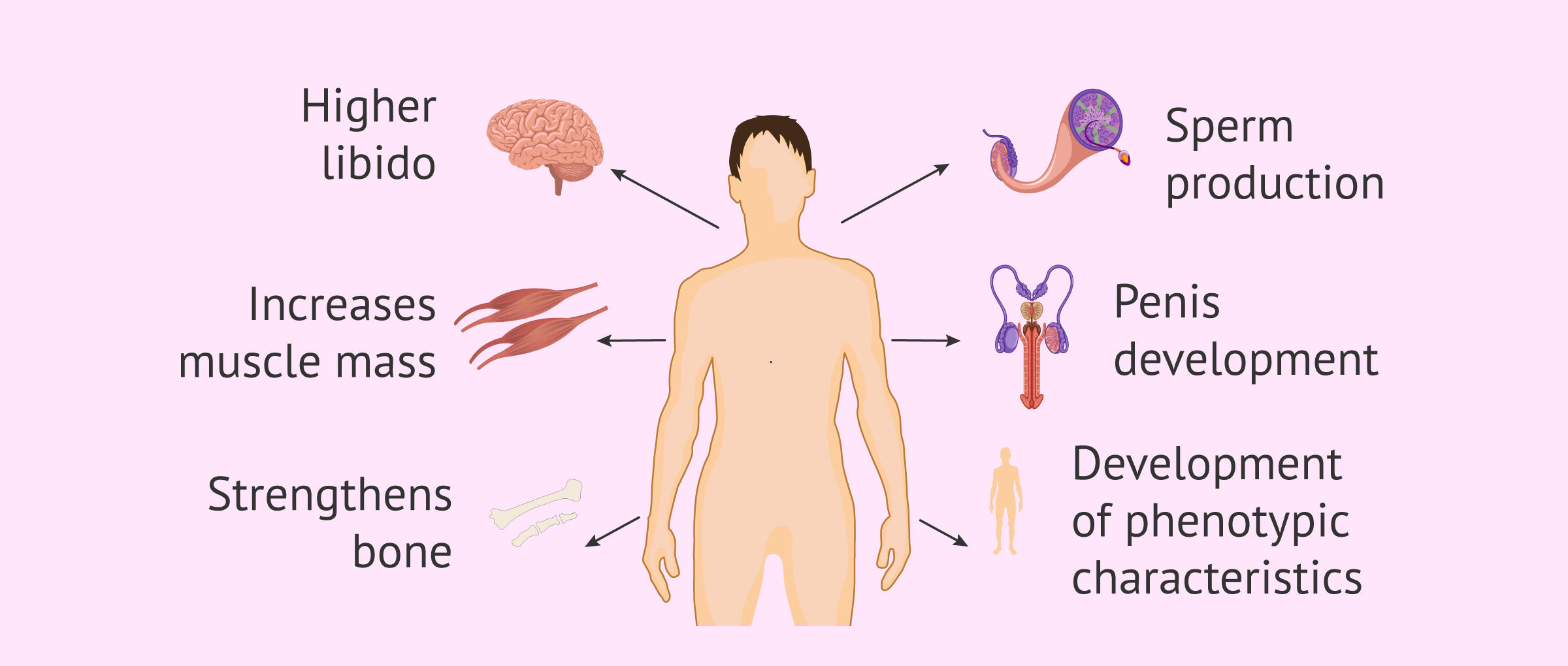Testosterone is a male sex hormone that is involved in the development of the genitals and the appearance of secondary sex characteristics in men.
It is an anabolic steroid that is produced mainly by the testicles, although a small amount is also released by the adrenal glands.
Testosterone is the androgenic hormone par excellence, but doesn’t exclusively occur in men. Women's ovaries and adrenal glands also produce a lesser amount of testosterone and are related to increased libido.
Provided below is an index with the 9 points we are going to expand on in this article.
- 1.
- 2.
- 3.
- 3.1.
- 3.2.
- 4.
- 4.1.
- 5.
- 6.
- 6.1.
- 6.2.
- 6.3.
- 6.4.
- 7.
- 8.
- 9.
What is testosterone?
Testosterone is a steroid hormone because it comes from cholesterol. Specifically, testosterone is part of the group of hormones called androgens and is the main male sex hormone.
Other hormones in the androgen group are dehydroepiandrosterone sufato (DHEAS), dehydroepiandrosterone (DHEA), androstendione and dihydrotestosterone (DHT). However, DHEAS, DHEA and androstenedione are really hormone precursors, as they need to be converted to testosterone and DHT in order to express their effects.
Another type of steroid sex hormones are estrogens. Traditionally estrogens are known as female hormones and androgens are known as male hormones, but both types are present in both women and men.
Testosterone production
In men, about 95% of testosterone is produced by the Leydig cells of the testicles.
This process is known as steroidogenesis and is perfectly regulated by the hypothalamus and the pituitary gland of the brain through the hormone LH.
Once expelled into the blood, testosterone travels through the bloodstream bound to other proteins: sex hormone binding globulin (SHBG) and albumin. Because of this binding, the function of testosterone is inhibited because it cannot bind to its receptor.
On the other hand, a small amount of testosterone remains free in the blood and is active to carry out its function.
Bioavailable testosterone is the sum of free testosterone and testosterone bound to albumin, as this protein has a low binding affinity to testosterone and can therefore release it quickly.
In the case of women, testosterone is produced by the teak cells of the ovaries and by the adrenal glands.
Function of testosterone
Testosterone appears in the first weeks of embryonic development and is responsible for the virilization of the male fetus.
This hormone plays a very important role in the development of the male reproductive system and in the development of his secondary sexual characteristics.
On the other hand, testosterone also intervenes in the sexuality of men and women, is very important for bone health, has anti-inflammatory and antioxidant action and also has favorable effects on blood vessels.
In the following sections we will discuss in greater detail which are the functions of testosterone for both sexes.
In men
In addition to the fetal period, testosterone becomes especially important in men after puberty. From the age of 11-13, testosterone production begins to increase in children and is maintained for the rest of their lives.
Below, we will detail the functions of testosterone in men's bodies:
- Promotes the development and growth of the penis, testicles, scrotum, and sexual secretory glands.
- Promotes the appearance of phenotypic characteristics of men: beard and hair on the body, deeper voice, growth of Adam's apple, etc..
- Stimulates the sperm production (spermatogenesis) in the seminiferous tubules and thus developing male fertility.
- It stimulates the maturation of spermatids to become spermatozoa and the definitive formation of semen.
- Develops bone growth and prevents osteoporosis.
- Promotes increased muscle mass and strength.
- Increases libido or sexual desire.
In women
In the case of women, they also produce testosterone and other androgens that are important for maintaining ovarian function, bone metabolism, cognitive function, and sexual function.
As far as female reproduction is concerned, the role of androgens is not entirely clear, although it is necessary to maintain adequate levels for correct ovarian functioning.
Androgens play a fundamental role in follicular development, so high levels can lead to excessive growth with dysfunctional formation of antral follicles, as in polycystic ovary syndrome (PCOS). On the other hand, too low levels of androgens are associated with low ovarian response and ovarian insufficiency.
Apart from this, androgens have been shown to increase levels of receptors for the FSH hormone in the follicles, which is responsible for inducing follicular growth.
Testosterone values
Hormone analysis is one of the basic diagnostic tests for the study of fertility in both men and women.
One of the hormones that is quantified is testosterone, as it can provide information on causes of infertility, decreased sexual desire, irregular menstrual cycles, testicular tumors, etc..
An adult man produces about 20 times more testosterone than an adult female. Specifically, these are the testosterone values that are considered normal:
- In men
- between 300-1,000 ng/dL.
- In woman
- between 15-70 ng/dL.
Low testosterone levels
Testosterone deficiency in men has several consequences on different physiological processes such as those listed below:
- Difficulty in maintaining an erection
- Lack of libido
- Low sperm count (oligozoospermia)
- Decreased strength and loss of muscle mass
- Fat accumulation and breast enlargement
- Decreased bone mineral density and osteoporosis
- Energy loss and increased fatigue
Men presenting those symptoms are recommended to make an appointment at a specialist in order to undergo hormonal exams and have their case evaluated.
If after several tests the doctor finds that the testosterone levels are low and the clinical manifestations cannot be contributed to any other cause, hormone therapy with testosterone may be applied.
Testosterone drugs
There are several types of medications to give testosterone exogenously:
- Via gel
- Androgel, Testogel...
- Via patches
- Androderm, Testopatch...
- Via injections
- Reandron, Testex Prolongatum...
- Via implant or chip
- Rejuvchip
The doctor responsible for the treatment will choose the method of administration of testosterone according to the specific deficit and the characteristics of the man or woman.
Artificially administered testosterone can have side effects, so medical follow-up and dose control are very important. The most common adverse effects are breast enlargement, fluid retention, and prostate growth.
The latter is the most important risk, so doctors usually perform a specific prostate analysis before treatment to ensure that there is no tumor in the area, decreasing the likelihood of cancer occurring after abnormal prostate growth.
FAQs from users
What is the function of testosterone in men?
Testosterone has two distinct actions on a man's body:
- Androgen effect: helps the formation and maintenance of male sexual characteristics such as the appearance of the beard, the change of voice, etc.
- Anabolic effect: increases bone complexion and strength in men, as well as stimulates bone growth and maturation.

How much testosterone do women produce?
50% of the testosterone in a woman's body comes from the conversion of other androgens, while the other 50% is produced directly in the ovary and the adrenal glands in equal parts.
Specifically, women produce between 0.1 and 0.4 mg of testosterone daily, while men produce between 5 and 7 mg daily.
99% of a woman's testosterone is bound to a protein called sex hormone-bound globulin (SHBG), which does not allow it to function. Therefore, only 1% of testosterone will be in free form and may have an effect on the body.
As menopause approaches, there is a decrease in androgen levels. However, the ovaries of menopausal women will continue to produce testosterone constantly.
Where can testosterone concentrations go down or up in women?
In addition to menopause, other situations that may decrease androgen concentrations include anorexia nervosa, medications such as contraceptives (due to increased SHBG concentrations), HIV, bilateral oophorectomy (surgical excision of both ovaries), and endocrine pathologies such as a failure of the adrenal glands or hypopituitarism.
On the contrary, there are circumstances in which higher levels of androgens are observed, such as polycystic ovary syndrome (PCOS)
What purpose does testosterone have during an IVF treatment?
Testosterone is sometimes used in assisted reproduction in an attempt to improve the response in women with low egg reserves.
Testosterone or DHEA pre-treatment appears to be associated with better live birth rates, although the quality of evidence is moderate.
Suggested for you
If you want to know more about childbirth and its natural development, don't miss the following article: Male and Female Sex Hormones - Definition & Functions.
You may also be interested in reference values for testosterone and other sexual hormones in order to evaluate fertility. Read more about here:
We make a great effort to provide you with the highest quality information.
🙏 Please share this article if you liked it. 💜💜 You help us continue!
References
Davis SR, Wahlin-Jacobsen S. Testosterone in women--the clinical significance. Lancet Diabetes Endocrinol. 2015 Dec;3(12):980-92 (View)
Nagels HE. Androgens (dehydroepiandrosterone or testosterone) for women undergoing assisted reproduction. Cochrane Database Syst Rev. 2015 Nov 26;(11):CD009749 (View)
Nieschlag E, Nieschlag S. ENDOCRINE HISTORY: The history of discovery, synthesis and development of testosterone for clinical use. Eur J Endocrinol. 2019 Jun 1;180(6):R201-R212 (View)
FAQs from users: 'What is the function of testosterone in men?', 'How much testosterone do women produce?', 'Where can testosterone concentrations go down or up in women?' and 'What purpose does testosterone have during an IVF treatment?'.








